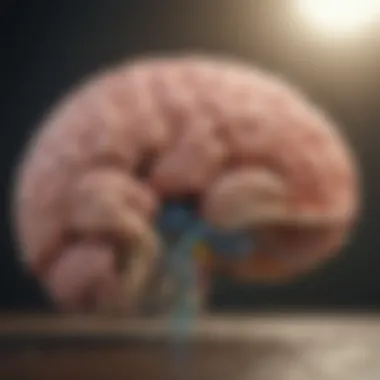Cerebral Palsy: Understanding Its Neurological Impact


Intro
Cerebral palsy is a complex neurological condition that results from brain injury or malformation during critical stages of development, often before birth. Understanding how cerebral palsy affects brain function is crucial for various stakeholders, including families, healthcare professionals, and researchers. This condition is not one-size-fits-all; it encompasses a range of types and manifestations, leading to varied implications in motor function, cognition, and quality of life. Consequently, we aim to explore the multifaceted nature of cerebral palsy in this article, with a focus on its origins in the brain and the resultant neurological outcomes.
Research Overview
Summary of Key Findings
Research into cerebral palsy has revealed significant insights into its etiology, clinical presentation, and interventions. Findings indicate that the condition is primarily linked to damage to the brain's motor areas, impacting not only movement but cognitive processes as well. Studies have categorized cerebral palsy into different types, including spastic, dyskinetic, and ataxic, each presenting unique challenges.
- Spastic Cerebral Palsy: Characterized by increased muscle tone, leading to stiff movements and difficulty with coordination.
- Dyskinetic Cerebral Palsy: Involves involuntary movements, affecting posture and control.
- Ataxic Cerebral Palsy: Marked by balance and coordination issues, impacting precise movements.
Each type presents distinct implications for treatment and quality of life, making comprehensive understanding essential for effective management.
Importance of the Research
The implications of cerebral palsy on brain function extend beyond the immediate physical challenges. Understanding these implications is key for developing informed treatment modalities. For example, cognitive challenges are often present alongside physical impairments. Recognizing this interconnectedness fosters a holistic approach to care, addressing not only mobility but also cognitive development and mental health. Future research directions may help delineate the relationship between early interventions and long-term outcomes for those living with cerebral palsy.
"Cerebral palsy is not merely a movement disorder; it is a condition that influences many aspects of life and development."
Methodology
Study Design
Research studies on cerebral palsy typically employ a variety of designs ranging from longitudinal studies to cross-sectional assessments. Longitudinal studies allow researchers to observe changes over time, providing insight into the progression of the condition and the efficacy of interventions.
Data Collection Techniques
Data collection methods in cerebral palsy research include clinical evaluations, surveys, and neuroimaging techniques. Clinical evaluations often involve standardized assessments of motor and cognitive functions. Neuroimaging, such as MRI scans, plays a crucial role in visualizing brain damage, helping to inform both diagnosis and treatment strategies.
Understanding Cerebral Palsy
Cerebral palsy is a critical subject in neurology and pediatric medicine. Understanding this condition provides insight into the complexities of brain development and its profound implications on individual lives. Cerebral palsy is not just a blanket term for motor difficulties; it entails a spectrum of disorders that emerge from varying brain conditions. This section aims to articulate the nuances of cerebral palsy, focusing on its definition, historical context, causes, symptoms, and effects on quality of life.
Recognizing these elements equips professionals and caregivers with essential knowledge for diagnosis, treatment, and support. The implications of understanding cerebral palsy extend beyond clinical practice into the realms of education, social policy, and community awareness. Enhanced awareness leads to improved resources and support systems for those affected.
Definition and Overview
Cerebral palsy refers to a group of neurodevelopmental disorders that primarily impact movement, posture, and coordination due to abnormalities in the brain. It is characterized by a variety of symptoms that can range from mild to severe and often includes difficulties with motor skills, muscle tone, and control.
Classically, this disorder is categorized into four main types based on the symptoms exhibited: spasticity, athetosis, ataxia, and mixed forms. Each type indicates a specific pattern of movement irregularities stemming from distinct areas of the brain being affected. It is estimated that 1 in 400 children may be diagnosed with some form of cerebral palsy, which underscores the necessity for comprehensive understanding.
The importance of early detection is crucial as interventions can be more effective when initiated promptly.
Historical Context
The journey to understanding cerebral palsy has evolved significantly over the last century. Initially, it was often misclassified and referred to as "little brain" or "cerebral paralysis". In the early 20th century, medical professionals began to recognize the intricate relationship between brain injury or dysfunction and resultant motor impairments.
In the 1950s, the classification of cerebral palsy became more refined, allowing experts to distinguish it from other conditions with similar presentations. Furthermore, advances in imaging technology have revolutionized how we view brain anomalies associated with cerebral palsy. This has facilitated a more precise identification of the types and their corresponding implications for development and treatment. As research continues to progress, understanding cerebral palsy will rely heavily on collaborative efforts integrating neurology, rehabilitation, and educational frameworks, which are vital for enhancing quality of life for individuals affected by this condition.
The Neurology of Cerebral Palsy
Understanding the neurology of cerebral palsy is crucial for several reasons. First, it links the physical manifestations of the condition to distinct anomalies in brain development. Cerebral palsy is primarily a motor disorder, but its origins stem from neurological impairments. This section addresses how these neurological conditions influence motor skills, cognition, and overall quality of life in affected individuals. By grasping the intricacies of brain function, professionals can better tailor interventions and support mechanisms for those living with cerebral palsy.
Brain Structure and Function
The brain plays a pivotal role in orchestrating voluntary movements, maintaining posture, and facilitating coordination. In individuals with cerebral palsy, structural abnormalities often present in key areas of the brain, including the motor cortex, basal ganglia, and cerebellum.
- Motor Cortex: This area controls the planning and execution of movements. Damage or dysfunction here can result in difficulties with muscle control.
- Basal Ganglia: It regulates motor function and movement fluidity. Its impairment can cause involuntary movements.
- Cerebellum: Essential for balance and coordination, damage to the cerebellum often leads to ataxia, characterized by an inability to coordinate voluntary movements.
Research indicates that these structural changes can be attributed to several factors, such as prenatal brain injuries and genetic predispositions. Increased understanding of how these areas interact can lead to more effective therapeutic strategies.


The Role of the Motor Cortex
The motor cortex is specifically significant in understanding cerebral palsy. It is divided into several areas responsible for different muscle groups.
In cases of spastic cerebral palsy, the motor cortex experiences neurodevelopmental disruptions typically related to damage during prenatal or natal phases. These disruptions can lead to spasticity, a condition where muscles stiffen, causing difficulties in movement.
- Neuroplasticity: Notably, the brain's ability to reorganize its connections—known as neuroplasticity—may offer avenues for rehabilitation. Therapies can sometimes stimulate the unaffected areas of the motor cortex to compensate for lost functions.
- Therapeutic Implications: Understanding the motor cortex's role can inform the choice of therapies, whether physical therapy or other interventions designed to improve functional outcomes.
"Recognizing how specific brain regions contribute to motor control can significantly influence treatment plans and quality of life for individuals with cerebral palsy."
Etiology of Cerebral Palsy
Understanding the etiology of cerebral palsy is crucial for several reasons. It allows for a comprehensive insight into not only the causative factors of this condition but also its prevention and management. The etiology encompasses various stages of development, including prenatal, perinatal, and postnatal factors. Each of these stages plays a significant role in the onset and progression of cerebral palsy. By analyzing these different factors, healthcare providers can identify at-risk populations and potentially intervene earlier.
Prenatal Factors
Prenatal factors refer to the influences that affect the fetus during pregnancy. Several aspects may contribute to the development of cerebral palsy. These include maternal infections, exposure to toxins, and poor prenatal care. Specific infections, such as rubella or cytomegalovirus, can lead to neural development issues. Additionally, maternal health conditions, like diabetes or hypertension, can negatively affect fetal brain growth.
Proper prenatal care is essential in minimizing these risks. Regular check-ups can help monitor the health of both mother and fetus, ensuring timely interventions when necessary.
Perinatal and Neonatal Factors
The perinatal and neonatal periods are equally critical in the etiology of cerebral palsy. Complications during childbirth, such as prolonged labor, can lead to oxygen deprivation (asphyxia) and result in brain injury. Low birth weight is also a strong risk factor; infants born prematurely or with low birth weight are at a higher risk of developing cerebral palsy.
Neonatal factors include issues that arise immediately after birth, such as infections, jaundice, or severe physiological stress. These conditions can adversely affect a newborn's brain development. Understanding these complications can help healthcare professionals better prepare for high-risk deliveries.
Postnatal Factors
Postnatal factors involve events that occur after birth. They include various injuries or illnesses during early childhood, like traumatic brain injury or severe infections like meningitis. These can lead to long-term neurological issues. Additionally, social factors such as lack of access to healthcare and poor living conditions may exacerbate the risks.
In summary, the etiology of cerebral palsy is multifaceted, encompassing a range of factors from prenatal health to environmental conditions post-birth. A comprehensive grasp of these elements is fundamental for prevention strategies and effective interventions, aiming to improve outcomes for affected individuals.
"Understanding the etiology is the first step toward prevention and effective treatment of cerebral palsy."
Healthcare providers, educators, and families must work collaboratively to address these factors. Only through a thorough understanding can we hope to mitigate the impact of cerebral palsy on individuals and their families.
Types of Cerebral Palsy
Understanding the types of cerebral palsy is crucial for several reasons. Firstly, recognizing the different classifications aids in establishing appropriate treatment strategies. Each type presents unique challenges and requires tailored therapeutic approaches. Moreover, insight into these types enhances the comprehension of the condition itself, which is pivotal for educators, healthcare providers, and families. By differentiating between the types, caregivers can provide better support aligned with the specific needs of the individual. This section delves into the four primary types of cerebral palsy: spastic, dyskinetic, ataxic, and mixed. Each of these types manifests distinct features and implications for brain function.
Spastic Cerebral Palsy
Spastic cerebral palsy is the most common type, affecting approximately 80% of individuals with the condition. It is characterized by muscle stiffness and tightness, resulting from damage to the motor cortex of the brain. This stiffness can lead to difficulties in movement and posture.
Individuals with spastic cerebral palsy often exhibit varying degrees of severity. Some may experience only minor movement restrictions, while others are severely limited and require adaptive equipment.
"Spasticity can significantly restrict a person's ability to perform everyday tasks and impacts overall mobility."
Notably, spastic cerebral palsy is further divided into categories based on the limbs affected:
- Spastic Hemiplegia: One side of the body is affected.
- Spastic Diplegia: Primarily the legs are affected, while arms may be less involved.
- Spastic Quadriplegia: All four limbs are affected significantly.
Dyskinetic Cerebral Palsy
Dyskinetic cerebral palsy is another prevalent form that features involuntary movements. This variability is due to damage primarily in the basal ganglia. Individuals may exhibit a mix of abnormal posture and fluctuating muscle tone. Movements can be slow and writhing or rapid and jerky, affecting coordination and speech.
This type complicates daily functions, making tasks such as eating and writing quite challenging. Dyskinetic cerebral palsy may be categorized into:
- Athetosis: Slow, writhing movements.
- Chorea: Quick, irregular movements.
- Dystonia: Twisting and repetitive movements.
The fluctuations in muscle tone can create barriers to mobility and self-care, leading to increased frustration.
Ataxic Cerebral Palsy


Ataxic cerebral palsy is the least common type, accounting for a smaller percentage of cases. This type is characterized by issues with balance and coordination, often due to damage in the cerebellum. Individuals may struggle with tasks that require precise movements, such as writing or buttoning shirts.
Ataxia may result in unsteady gait. This can lead to falls, increasing the focus on safety measures for individuals affected. The impact on fine motor skills is significant and affects regular activities such as drawing or using utensils.
Mixed Cerebral Palsy
Mixed cerebral palsy encompasses a combination of the aforementioned types. Individuals with mixed cerebral palsy may experience symptoms of spasticity in conjunction with dyskinetic or ataxic components. This type presents a unique set of challenges, as the dual impact of muscular control and coordination difficulties creates a multifaceted profile.
Care teams must adopt a holistic approach, considering the complexity of affected areas during treatment planning. With the variety of symptoms, individuals may have differing requirements for support and treatment.
In summary, the classification of cerebral palsy into types is fundamental to understanding the diverse presentations of this condition. Each type carries specific characteristics, treatment challenges, and implications for brain function. A precise diagnosis is essential for effective management and enhancing the quality of life for those affected.
Symptoms and Diagnosis
Understanding the symptoms and diagnosis of cerebral palsy is crucial for identifying the condition early and facilitating appropriate interventions. Early diagnosis can lead to more effective treatment strategies, allowing individuals to achieve their highest potential. Recognizing both motor and cognitive symptoms enables healthcare professionals and caregivers to provide tailored support, enhancing the quality of life for those affected.
Motor Symptoms
Motor symptoms of cerebral palsy vary widely among individuals, primarily due to the diverse nature of brain injury that leads to the condition. Common motor symptoms include:
- Spasticity: This is characterized by stiff or tight muscles, leading to restricted movement. Individuals may exhibit difficulty in performing everyday tasks.
- Weakness: Reduced muscle strength can make it hard for individuals to stand, walk, or perform coordinated movements.
- Involuntary Movements: These are often present in dyskinetic forms of cerebral palsy, leading to chaotic and uncontrolled motions that can interfere with coordination.
- Ataxia: This refers to issues in balance and coordination, resulting in difficulty with walking and fine motor skills.
Motor symptoms not only impact physical activity but can also affect social interactions and self-esteem. As such, caregivers and therapists should prioritize early identification and management.
Cognitive and Behavioral Symptoms
Cognitive and behavioral symptoms in individuals with cerebral palsy may not be immediately noticeable. However, they can significantly impact daily life. It is essential to assess these areas alongside motor symptoms. Some key points include:
- Learning Disabilities: Many children with cerebral palsy may face challenges in areas like attention, memory, and overall learning capabilities.
- Behavioral Issues: Anxiety, depression, and social withdrawal can be common due to difficulties faced in daily functions.
- Communication Delays: Some children may also experience challenges in speech and language development, requiring speech therapy.
Recognizing cognitive and behavioral symptoms is vital for creating comprehensive treatment plans that address all aspects of an individual's needs.
Diagnostic Criteria
The diagnosis of cerebral palsy typically involves several steps to ensure an accurate evaluation. The main criteria include:
- Detailed Medical History: Physicians usually begin with a thorough medical history and developmental assessment of the child.
- Neurological Examination: This is critical for establishing the presence of motor impairments and observing muscle tone and coordination.
- Imaging Tests: Techniques, such as MRI or CT scans, can help visualize any brain abnormalities that may correlate with symptoms.
- Developmental Screenings: These assessments explore various stages of physical, cognitive, and emotional growth to determine if they deviate from typical benchmarks.
Understanding the diagnostic criteria aids in distinguishing cerebral palsy from other neurological disorders, ensuring that individuals receive the most appropriate resources and interventions early in life.
Impact on Quality of Life
The consequences of cerebral palsy extend beyond physical limitations and neurological challenges. Understanding the implications on quality of life is essential to fully grasp the condition's overarching effects. Quality of life encompasses several factors, including physical health, emotional well-being, and the ability to engage in social activities. For individuals with cerebral palsy, these elements can significantly vary depending on the severity of the condition and the type of interventions available. Recognizing how cerebral palsy affects quality of life can lead to more effective support systems and interventions.
Physical Limitations
Physical limitations are often the most visible aspect of cerebral palsy but vary greatly among affected individuals. These limitations can manifest in several forms:
- Mobility Challenges: Many individuals experience difficulties with walking, which can range from mild gait irregularities to the need for wheelchair assistance.
- Coordination Issues: Poor muscle control can lead to problems with fine motor skills. Tasks like writing, typing, or even buttoning a shirt can become quite difficult.
- Pain and Fatigue: Chronic pain and muscle fatigue are common. They contribute to a decreased ability to partake in everyday activities.
- Overall Physical Health: Complications such as joint deformities or respiratory issues can arise, impacting general health.
"Improving the physical capabilities of individuals with cerebral palsy can greatly enhance their independence and overall well-being."
Addressing these limitations through therapies and technological aids is crucial. Physical therapy and assistive devices like orthotic braces or wheelchairs play pivotal roles in enabling movement and participation in daily activities.
Psychosocial Challenges
Psychosocial challenges form another critical aspect of quality of life for individuals with cerebral palsy. Social interaction and mental health are often deeply intertwined. Key factors include:
- Social Isolation: Due to mobility or communication barriers, individuals may struggle to engage socially, leading to feelings of loneliness or depression.
- Self-esteem Issues: Physical limitations can affect self-image and confidence. Comparisons to peers can exacerbate feelings of inadequacy.
- Access to Education: The ability to attend school or participate in educational settings can be a considerable challenge. Limited access to specialized programs may hinder learning opportunities.
- Mental Health Disorders: Individuals may be more prone to anxiety and depression, resulting from the challenges they face daily.
Strong support systems—ranging from family to community resources—can significantly lessen these psychosocial challenges. Programs promoting social skills can assist in building relationships and networks, which are essential for emotional well-being. Further, mental health resources can help individuals cope with the psychological burdens that often accompany the physical limitations of cerebral palsy.


Understanding the full impact of cerebral palsy on quality of life provides crucial insights for parents, caregivers, and professionals involved in the care and education of individuals affected by this condition. Advocacy for comprehensive treatment approaches must prioritize both physical and psychosocial well-being to enhance the quality of life for all affected.
Current Treatment Options
The treatment of cerebral palsy is multifaceted, reflecting the diverse needs and challenges faced by individuals with this condition. These treatment options are not solely focused on eliminating symptoms but rather aimed at enhancing the quality of life. Each method holds specific advantages, but considerations about individual patient needs and the nature of their cerebral palsy are crucial. The integration of different treatment modalities is often necessary for comprehensive management.
Physical Therapy
Physical therapy plays a vital role in managing cerebral palsy, focusing on improving mobility, strength, and overall physical function. Customized programs aim to enhance motor skills through targeted exercises. Common techniques include stretching exercises, posture training, and gait training. One significant benefit of physical therapy is its potential to reduce the risk of joint deformities. Additionally, it can help in maintaining muscle tone, which is often critical for those with spastic types of cerebral palsy. Engaging with a skilled physical therapist ensures that the treatment aligns with the evolving abilities and challenges faced by the individual.
Medications
Medications are often prescribed to manage specific symptoms associated with cerebral palsy, particularly those related to spasticity and muscle control. Commonly used medications include Baclofen and Diazepam, which can aid in reducing muscle stiffness and spasms. The choice of medication must be made carefully, as side effects can vary widely among individuals. Monitoring the patient’s response to medications is essential, as adjustments may be necessary over time. It is also important to consider the potential interactions between multiple drugs, especially in children who may be on various treatment regimens for related conditions.
Surgical Interventions
For some individuals, surgical interventions can significantly improve function and quality of life. These may include orthopedic surgeries aimed at correcting or preventing deformities. Selective dorsal rhizotomy is another procedure that targets the nerve pathways involved in spasticity, potentially offering long-term relief from muscle tension. It's essential to weigh the risks and benefits of surgery, as recovery can be lengthy and may require supplementary therapies afterward. Consulting with a specialized team can help in understanding the implications of such interventions and setting realistic goals.
Assistive Technologies
Assistive technologies are crucial in promoting independence and enhancing daily living for those with cerebral palsy. Various devices are available, including wheelchairs, communication aids, and adaptive tools for feeding or writing. These aids can empower individuals to perform tasks with greater ease and encourage participation in social and educational activities. The selection of appropriate technology should be based on the individual's specific needs and capabilities. Regular assessment can ensure that the technologies remain fitting as the individual’s disability changes over time.
"An integrated approach is essential when planning treatment for cerebral palsy. This means combining therapies, medications, and technologies to optimize function and well-being."
The holistic approach to treating cerebral palsy reflects not only the medical aspects but also the emotional and social dimensions of living with this condition. A thorough understanding of the available treatment options opens the door to better management strategies and improved life experiences for those affected.
Emerging Research and Future Directions
The field of cerebral palsy is progressing rapidly, with new research emerging that promises to deepen our understanding of this complex condition and improve treatment options. Emerging research is important because it often highlights innovative strategies and interventions that can lead to improved quality of life for individuals with cerebral palsy. This section will discuss two crucial areas of investigation: innovative therapies and genetic research.
Innovative Therapies
Innovative therapies are reshaping the approach to treating cerebral palsy.
- Robotic-Assisted Therapy: This therapy utilizes robotic devices to assist with physical rehabilitation. It can be particularly useful for improving motor skills in children with cerebral palsy.
- Virtual Reality (VR) Training: VR creates immersive environments that may encourage engagement in rehabilitation exercises. It also makes therapy more enjoyable.
- Neurofeedback: This is an approach that trains individuals to control brain activity through real-time feedback. This treatment shows promise in improving cognitive functions.
These therapies address specific symptoms of cerebral palsy, leading to enhanced mobility, increased independence, and better social interaction among patients. For instance, early research indicates that robotic-assisted therapy can significantly improve upper limb function. However, more extensive studies are needed to evaluate long-term effectiveness and accessibility of these therapies on a wider scale.
"Continued exploration of innovative therapies is essential. They can potentially bridge the gap in treatment options available today."
Genetic Research
Genetic research holds significant potential in understanding cerebral palsy. Identifying genes associated with this condition can lead to various outcomes:
- Understanding Mechanisms: It can unveil how genetic mutations contribute to brain damage and lead to the development of cerebral palsy.
- Tailored Treatments: By understanding the genetic basis, treatments can be customized according to individual needs, resulting in more effective interventions.
- Prevention Strategies: Identifying at-risk populations through genetic testing can open avenues for preventive measures before the onset of symptoms.
Many researchers are now exploring genes involved in brain development and function. This exploration could not only improve diagnosis but also provide insights into the trajectory of the condition. However, ethical considerations must be taken into account as the field of genetic research advances.
Endings and Implications
Cerebral palsy is a complex condition deeply rooted in neurological factors that considerably influence motor and cognitive capacities. Understanding the implications of this disorder is crucial. It informs caregivers, educators, and healthcare professionals of the specific challenges faced by individuals with cerebral palsy. Addressing these needs can significantly enhance quality of life. Moreover, the insights gained from the study of cerebral palsy contribute to advancements in treatment protocols and support systems.
Knowledge about the various types of cerebral palsy can help tailor interventions to complement individual abilities and challenges. Spastic, dyskinetic, ataxic, or mixed types each have unique symptoms that impact daily living. By understanding these differences, practitioners can provide more personalized care, thus promoting better outcomes.
Summary of Findings
The article highlights several key points:
- Neurological Underpinnings: Cerebral palsy results from brain injuries, often occurring before or during birth. This affects neural pathways that control movement.
- Variability of Symptoms: Individuals experience a broad range of symptoms, from physical impairments to cognitive challenges, which vary significantly depending on the type and severity of cerebral palsy.
- Quality of Life Considerations: Both physical limitations and psychosocial challenges highlight the importance of comprehensive care that addresses emotional and social well-being.
- Innovative Treatments: Emerging therapies, such as robotic-assisted therapy and genetic research, provide hope for more effective interventions that can improve functionality and quality of life.
Future Perspectives
In the future, research is expected to progress in several directions:
- Technological Integration: The development of advanced technologies, like artificial intelligence, could help in personalizing treatment and monitoring progress more effectively.
- Genetic Understanding: Continued exploration of genetic factors may uncover new insights into the causes of cerebral palsy, leading to preventative strategies or more targeted therapies.
- Interdisciplinary Approaches: As our understanding grows, integrating various fields—neurology, genetics, rehabilitation science—will provide a more holistic perspective, improving patient outcomes.
"Understanding cerebral palsy is not just a scientific endeavor; it is a call to advocate for better support systems and treatment strategies that can truly transform lives."
Through an increased focus on research and a commitment to individualized care, the future looks promising for individuals living with cerebral palsy. The implications of our findings extend beyond academic interest, emphasizing the need for actionable steps to improve everyday experiences for those affected.



